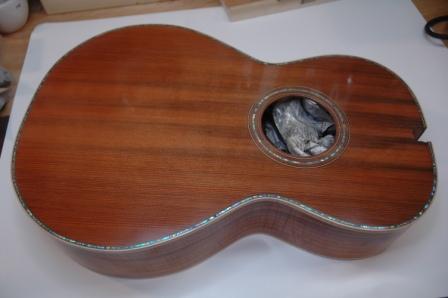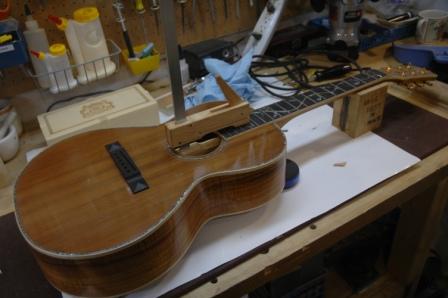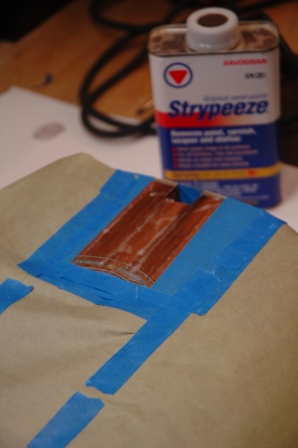Guitar 906 – Neck Installed
June 11, 2010
Carl comes to visit on the 25th. I have been the great pretender for too long. His guitar will be ready when he arrives. No excuses. I made a giant leap toward that goal today by knocking down that finish to a glorious sheen. The buffing wheel does wonderful things. I have learned, though, that there’s only so far that buffing wheel can hide incomplete sanding. And, I have learned how complete I must sand in order to buff to my desired finish.

I have also learned the importance of grain filling. As I tend to finish on the light side (too much lacquer effects the sound, yet too much lacquer hides all blemishes), I can see every leftover crease, unfilled grain-ule, and divot from the sharp edge of the bench vise. Grain filling is that step before finishing where you level off the surface with a filler, and with most tropical hardwoods, there is a bit of open grain. Since I don’t rely on the final finish to fill the grain, I must be much more diligent in my grain filling step(s). I will not, I repeat, I will not proceed to the finishing step until every grain has been filled and leveled.

Now, the guitar in question, Carl’s Koa Parlor, does have a very interesting “grain feature”. The finish is not glass smooth, but accented with the natural grain of the wood. Visually it is pleasing (unless you want glass), but tonally, it will be for the best, as the lacquer is just enough to protect, but not enough to deflect from the sound the wood wants to make.
After buffing, I dry set the neck and checked the neck angle and masked the area arount the end of the fretboard where it will be glued to the top. The neck angle on this guitar is much closer to my preferred than any previously. What that means is that no matter how diligent I may be determining the neck angle, after all comes together and it’s time to install the neck, it’s always a little steeper than I planned. This guitar, a victim of multiple neck angle experiments, is much closer to ideal.
Strypeeze is used to remove the lacquer from the top where the fretboard will be glued. The following picture is a product placement, from which I have been handsomely compensated.
Once the goop has been carefully scraped away and neutralized with water, the neck can be glued to the body. I use a mortise and tenon bolt on neck, but the surface of the guitar top is glued to the fretboard for stability. This means that in future neck resets, only the section of the neck attached (glued) to the top needs to be heated and relieved.


Carl Purdom on 13 Jun 2010 at 10:30 am #
I very excited to hear it make some music.